موانع حرفه ای درک شده و نتایج حرفه ای در میان دانشجویان دانشگاه: بررسی میانجیگری و اثرات اعتدال Perceived career barriers and vocational outcomes among university undergraduates: Exploring mediation and moderation effects
- نوع فایل : کتاب
- زبان : انگلیسی
- ناشر : Elsevier
- چاپ و سال / کشور: 2017
توضیحات
رشته های مرتبط علوم اجتماعی و روانشناسی
مجله رفتار حرفه ای – Journal of Vocational Behavior
دانشگاه گروه روانشناسی عمومی، ویولن، لیتوانی
نشریه نشریه الزویر
مجله رفتار حرفه ای – Journal of Vocational Behavior
دانشگاه گروه روانشناسی عمومی، ویولن، لیتوانی
نشریه نشریه الزویر
Description
1. Introduction Perceived career barriers are generally defined as perceived difficulties in achieving career goals. Specifically, these can be “events or conditions, within the person or in his or her environment, that make career progress difficult” (Swanson & Woitke, 1997, p. 434). In the context of this study, perceived barriers refer to perceived difficulties in attaining the chosen academic major. As research shows, there may be quite many barriers that people encounter in their careers (Swanson & Tokar, 1991). Although there is no one agreed upon classification, previous studies provide enough empirical basis for distinguishing between the internal and external barriers (see Creed, Patton, & Bartrum, 2004; Lent, Brown, & Hackett, 2000; McWhirter, Torres, Salgado, & Valdez, 2007). Internal barriers are person-focused and refer to such factors as perceived lack of ability, motivation or interest in pursuing career goals. External barriers are environment-focused and refer to various contextual factors, such as fi- nancial problems, family demands, employment restrictions, and the like. Although some findings on perceived career barriers reveal their unexpectedly positive effects (e.g. Hirschi, Lee, Porfeli, & Vondracek, 2013; Lindley, 2005) implying that barriers can possibly serve not only as hindrance, but also as challenge factors in career development (Hirschi et al., 2013), they are usually explored as a negative precondition impeding career development. In line with this, they have been linked to career indecision (Albert & Luzzo, 1999; Constantine, Wallace, & Kindaichi, 2005; Creed et al., 2004), less career planning (Cardoso & Moreira, 2009) and readiness (Hirschi, 2011), lower or less adequate aspirations (Creed, Wong, & Hood, 2009; Jackson, Kacanski, Rust, & Beck, 2006; Kenny, Blustein, Chaves, Grossman, & Gallagher, 2003), and have been reported to have an effect upon post-secondary career plans (McWhirter et al., 2007) and career expectations in children (Creed, Conlon, & Zimmer-Gembeck, 2007). However, despite an increased interest in this topic, the findings fail to provide a comprehensive picture of the role that perceived barriers play in career choice. On one hand, this is because perceptions of barriers are often analyzed in specific contexts (i.e. in female samples or minority populations). On the other hand, the effect of perceived career barriers is largely bound to respondents’ career stage and can hardly be generalized across all age groups. For instance, the outcomes of high school students’ perceived future-related barriers do not necessarily compare to those experienced by their older counterparts.


